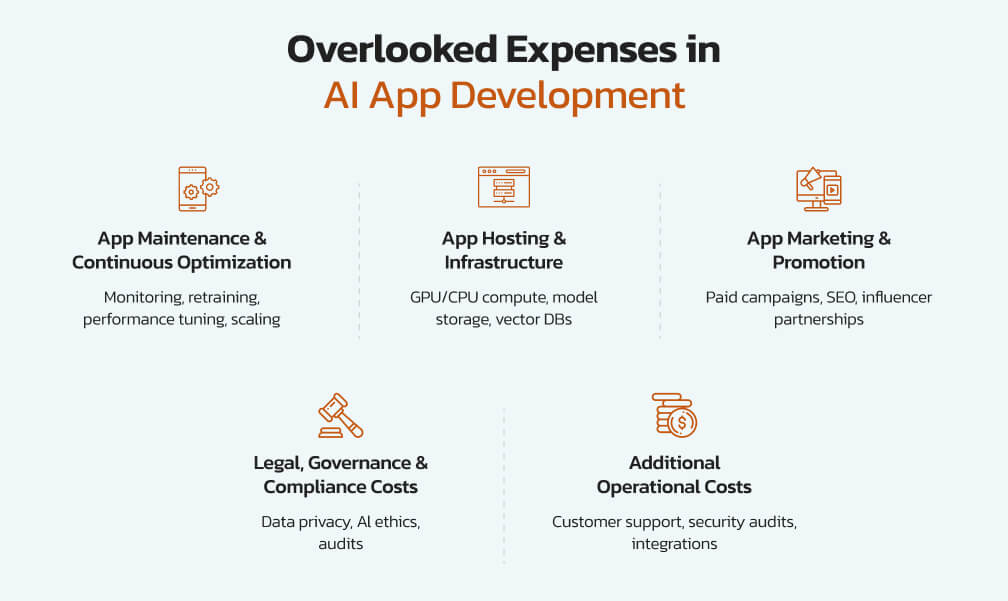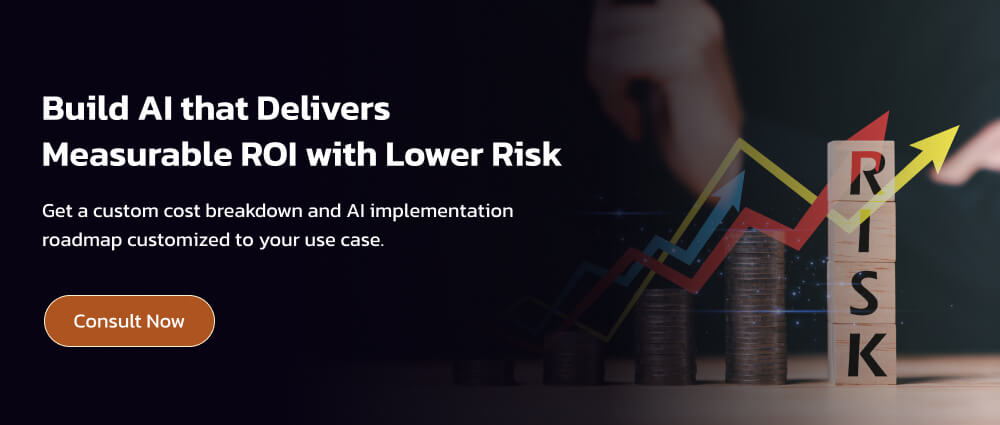
Over the past few years, AI has evolved from an experimental initiative to a strategic growth engine driving digital transformation across enterprises. The investment trends reflect this shift, propelling the AI technology market toward an estimated $1.8 trillion by 2030. Companies are no longer asking if they should invest in AI, but the question is now “how much does AI development cost?” and what ROI it can bring, as well as how to build a financial roadmap.
This blog provides a comprehensive, executive-level breakdown of AI development costs, including project size, complexity, team structure, data requirements, and long-term ownership cost.
- Why AI Costs Vary Dramatically in the Market
- What Influences the Pricing of AI Solutions?
- Overlooked Expenses in AI App Development
- Industry-Wise AI Development Cost
- Ways to Optimize AI Apps Development Costs
- Smart Tips to Monetize an AI App
- Summing Up
- How can TechnoScore help?
- Frequently Asked Questions
Why AI Costs Vary Dramatically in the Market
AI development is not buying a pre-built tool; you’re building an intelligent system that learns, adapts, and integrates with your business ecosystem. This means a combination of different factors influences the AI development cost.
- System complexity
- Data readiness
- Integration depth
- Infrastructure usage
- Cloud computing needs
- Domain-specific accuracy expectations
- Long-term monitoring and retraining
What Influences the Pricing of AI Solutions?
To understand the factors that influence AI app development costs, consider the following cost pillars for evaluation.
1. Complexity of the Use Case
Simple automation and structured data models are cost-efficient, while Generative AI or custom LLMs require significant investment.
| Complexity Level | Examples | Cost Range |
|---|---|---|
| Basic AI | Recommendation rules, sentiment analysis, classifiers | $15,000–$40,000 |
| Moderate AI | Predictive scoring, NLP pipelines, custom chatbot | $40,000–$150,000 |
| Advanced AI | Computer vision, speech-to-text, generative AI apps | $150,000–$500,000+ |
| Enterprise AI | Custom LLMs, AI agent ecosystems, multi-modal models | $ 500,000 – $2M+ |
2. Data Availability & Quality
The AI implementation cost is primarily tied to data work, accounting for 50-60%.
Costs include:
- Data collection
- Data cleaning & preprocessing
- Classification & labeling
- Enrichment
- Domain-specific curation
Data annotation costs range from $25-$45/hour, depending on domain complexity (healthcare, legal, and financial require expert labeling).
3. Model Training Approach
Choosing the right model training approach is a crucial aspect of the overall AI development cost.
| Model Training Path | Description | Cost Range |
|---|---|---|
| Use Pre-Trained Models | Leverage models like OpenAI, Claude, and Llama with minimal customization. | $10,000 – $60,000 |
| Fine-Tune Existing Models | Domain fine-tuning on your proprietary data; higher accuracy. | $60,000 – $250,000 |
| Build Custom Models from Scratch | Train ML or LLM models using large proprietary datasets. | $300,000 – $1M+ |
4. Team Structure & Talent Costs
Team structure is one of the most significant variables in accurately estimating the cost of AI development. Whether you rely on an internal team or hire AI developer, it will significantly impact hourly rates, delivery speed, and the depth of AI expertise available. The table below highlights how each team model affects cost, capability, and scalability.
| Role | Hourly Rate |
|---|---|
| ML Engineer | $120-180/hr |
| Data Scientist | $100-160/hr |
| MLOps Engineer | $120-170/hr |
| AI Architect | $150-220/hr |
| AI Consultant | $150-250/hr |
| Senior Backend Engineer | $90-140/hr |
Overlooked Expenses in AI App Development

Most business groups prioritize building costs, but several downstream expenses are often ignored during budgeting, leading to unexpected overruns and inflated total cost of ownership (TCO). These components can impact the AI return on investment (ROI) if not planned upfront.
1. App Maintenance & Continuous Optimization
AI applications don’t follow the traditional “build once, maintain occasionally” lifecycle.
They require ongoing:
- Model monitoring
- Retraining of data
- Performance optimizations
- Infrastructure scaling
- Regular bug fixes and security updates
This becomes a recurring AI maintenance cost, and failing to plan a budget for this creates operational bottlenecks.
2. App Hosting & Infrastructure
AI operates using LLMs, GPUs, or real-time inference, which need higher hosting expenses than traditional apps.
- GPU/CPU compute for inference
- Model storage
- Vector databases for RAG
- Observability and logging tools
- API consumption (OpenAI and Anthropic)
Depending on volume, hosting can range from $500 to $10,000 or more per month, and this must be included in the initial cost estimates.
3. App Marketing & Promotion
Even the best AI apps fail to succeed in the digital world without visibility.
Companies often overlook:
- Paid campaigns (Google Ads, Meta, LinkedIn)
- App Store optimization
- Influencer or partner promotions
- Content creation (blogs, videos, demos)
- Retention funnels
- Email/SMS automation
Go-to-market (GTM) budgets often equal or exceed the average cost of AI app development, especially in B2C and SaaS categories.
4. Legal, Governance & Compliance Costs
AI encounters unique compliance obligations that differ from those of standard app development.
These may include:
- Data privacy assessments (GDPR, CCPA, HIPAA)
- AI safety and transparency audits
- Policy documentation
- User consent flows
- Model explainability requirements
- Third-party data usage agreements
Legal and compliance efforts can range from $10,000 to over $100,000, depending on the industry and regulations.
5. Additional Operational Costs
Beyond the technical, legal, and marketing, several operational expenses often go unnoticed:
- Customer support for AI-driven interactions
- ML Ops engineers to maintain pipelines
- Security audits & penetration testing
- Version upgrades of frameworks or models
- App store fees (iOS/Android)
- Integration upkeep with CRMs, ERPs, or external APIs
These ensure that your AI app stays competitive, compliant, and optimized in a rapidly evolving landscape.
Industry-Wise AI Development Cost
AI solution costs vary for every industry, reflecting differences in data complexity, regulatory requirements, and customization needs. Below is a concise comparison of key sectors:
| Industry | AI Use Case | Cost Range |
|---|---|---|
| BFSI | Fraud detection, credit scoring, risk modeling, automation | $300,000 – $1M |
| Logistics | Route optimization, predictive maintenance, and demand prediction | $200,000 – $750,000 |
| EdTech | Personalized learning AI, grading automation, chat-based tutoring | $100,000 – $400,000 |
| Manufacturing | Visual QC, anomaly detection, robotics | $ 250,000 – $ 900,000 |
Ways to Optimize AI Apps Development Costs
The goal isn’t to cut costs blindly but to optimize investment, streamline delivery, and ensure the AI product reaches the market with both precision and scalability. Below are a few tips for cost efficiency without degrading model performance or user experience.
1. Choose the Right Model Strategy Early
Your model-selection strategy impacts 40–60% of your total AI spend.
- Start with pre-trained models
- Move to fine-tuning only when needed
- Avoid custom model development
2. Control Data-Related Costs
Data is the largest hidden cost for any AI software development.
- Use synthetic data to reduce collection and annotation costs.
- Adopt active learning to train on only the most valuable labeled samples.
- Leverage automation tools for cleaning, tagging, and deduplication.
3. Build an MVP
AI projects carry higher uncertainty than traditional app builds. To address this, an MVP approach allows you to:
- Test the core model performance with limited data
- Understand real-world accuracy gaps before committing to full-scale training
- Avoid investing in features users don’t need
- Minimize rework by validating the technical direction early
4. Build the Right Team Structure
Avoid oversized or under-skilled teams for your AI project.
- Start with a small and experienced team of AI engineers, MLOps, and full-stack developers.
- Only hire once product direction stabilizes.
- Consult AI development services for niche tasks to minimize long-term payroll expenses.
5. Optimize Infrastructure & Compute Usage
Most teams overspend on GPU clusters.
- Use auto-scaling GPU instances instead of always-on compute.
- Implement checkpointing, model pruning, and quantization to reduce training time and improve efficiency.
- Shift training jobs to spot instances wherever feasible.
- For inference-heavy applications, deploy serverless endpoints or GPU-sharing architectures.
Smart Tips to Monetize an AI App
Building an AI app to deliver continuous and compounding value needs expert tips. Below are the most effective models used across AI startups and enterprise platforms.
1. SaaS Model
A subscription model brings recurring revenue by charging users monthly or annually for continued access to core AI features. You can share plans based on feature depth, usage limits, and enterprise requirements.
2. Usage-Based / Pay-As-You-Go Pricing
This model monetizes actual AI consumption rather than access. Users pay for tokens, API calls, inference minutes, or data processed. High-usage customers naturally become high-revenue drivers.
3. Freemium Model
Freemium helps build rapid market penetration by allowing users to try the core product for free, thereby increasing its adoption rate. Revenue is generated from upselling premium features, such as unlimited generations, faster model performance, and advanced templates.
4. In-App AI Credits
This model introduces purchase credits for additional features, agent tasks, or specialized services. It enhances monetization flexibility and lets power users scale usage without committing to higher subscriptions.
Summing Up
AI development isn’t just a technical investment but a strategic accelerator for long-term competitiveness. While the AI development cost varies by complexity, industry, team structure, and model strategy, the real question to ask is not the cost, but how quickly it generates measurable ROI. Companies that follow a phased approach, starting with an MVP first, an optimized data strategy, and smart model selection, consistently achieve faster deployment with desired ROI. With the right AI consulting service provider, architecture, and a clear roadmap, AI stops being an expensive experiment and becomes a scalable growth engine.
How can TechnoScore help?
TechnoScore helps organizations accelerate AI adoption with a delivery model engineered for speed, accuracy, and long-term ROI. Our team specializes in AI integration services, ensuring your workflow models, data pipelines, and legacy systems function as a unified, high-performance ecosystem. From connecting LLMs, CRMs, and ERPs directly into workflows, we help you convert isolated AI features into revenue-driving capabilities.
Frequently Asked Questions
1. How much does custom AI chatbot development cost?
The cost of AI chatbot development typically ranges from $1,000 to $5000+, depending on complexity, model type, data requirements, and team structure. Enterprise-grade or custom AI solutions can cost over $10000.
2. What influences the cost of building an AI application?
Key cost drivers include data preparation, model selection, integrations, infrastructure, compliance, and ongoing maintenance. Complexity and real-time performance needs significantly impact final pricing.
3. Is AI development worth the investment for small businesses?
Yes, when scoped properly. Starting with an MVP or task-specific solution helps small businesses reduce risk and reach ROI faster while controlling budget.
4. How long does it take to develop an AI app?
Most AI apps take 3–9 months, depending on model complexity, data availability, integration needs, and testing cycles. Enterprise systems may require phased rollouts.
5. What is the average AI maintenance cost?
AI maintenance typically accounts for 15–20% of the initial development cost annually, covering model retraining, monitoring, infrastructure, and feature updates.
6. Can AI reduce operational costs for companies?
Absolutely. AI can automate workflows, reduce manual effort, improve accuracy, and accelerate decision-making. This leads to substantial long-term savings and higher ROI.


